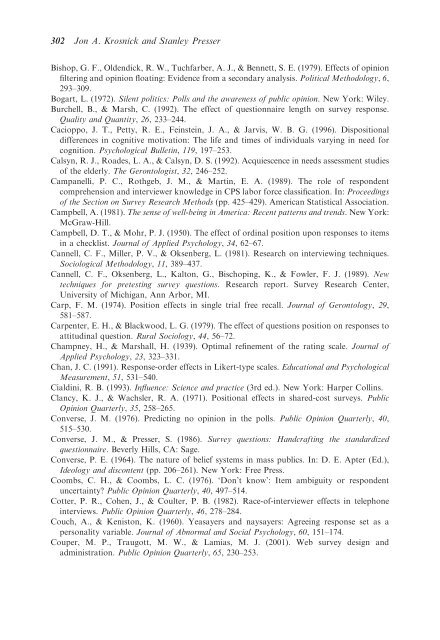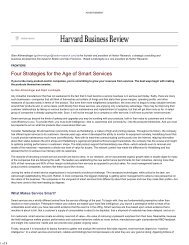Question and Questionnaire Design - Stanford University
Question and Questionnaire Design - Stanford University
Question and Questionnaire Design - Stanford University
Create successful ePaper yourself
Turn your PDF publications into a flip-book with our unique Google optimized e-Paper software.
302 Jon A. Krosnick <strong>and</strong> Stanley PresserBishop, G. F., Oldendick, R. W., Tuchfarber, A. J., & Bennett, S. E. (1979). Effects of opinionfiltering <strong>and</strong> opinion floating: Evidence from a secondary analysis. Political Methodology, 6,293–309.Bogart, L. (1972). Silent politics: Polls <strong>and</strong> the awareness of public opinion. New York: Wiley.Burchell, B., & Marsh, C. (1992). The effect of questionnaire length on survey response.Quality <strong>and</strong> Quantity, 26, 233–244.Cacioppo, J. T., Petty, R. E., Feinstein, J. A., & Jarvis, W. B. G. (1996). Dispositionaldifferences in cognitive motivation: The life <strong>and</strong> times of individuals varying in need forcognition. Psychological Bulletin, 119, 197–253.Calsyn, R. J., Roades, L. A., & Calsyn, D. S. (1992). Acquiescence in needs assessment studiesof the elderly. The Gerontologist, 32, 246–252.Campanelli, P. C., Rothgeb, J. M., & Martin, E. A. (1989). The role of respondentcomprehension <strong>and</strong> interviewer knowledge in CPS labor force classification. In: Proceedingsof the Section on Survey Research Methods (pp. 425–429). American Statistical Association.Campbell, A. (1981). The sense of well-being in America: Recent patterns <strong>and</strong> trends. New York:McGraw-Hill.Campbell, D. T., & Mohr, P. J. (1950). The effect of ordinal position upon responses to itemsin a checklist. Journal of Applied Psychology, 34, 62–67.Cannell, C. F., Miller, P. V., & Oksenberg, L. (1981). Research on interviewing techniques.Sociological Methodology, 11, 389–437.Cannell, C. F., Oksenberg, L., Kalton, G., Bischoping, K., & Fowler, F. J. (1989). Newtechniques for pretesting survey questions. Research report. Survey Research Center,<strong>University</strong> of Michigan, Ann Arbor, MI.Carp, F. M. (1974). Position effects in single trial free recall. Journal of Gerontology, 29,581–587.Carpenter, E. H., & Blackwood, L. G. (1979). The effect of questions position on responses toattitudinal question. Rural Sociology, 44, 56–72.Champney, H., & Marshall, H. (1939). Optimal refinement of the rating scale. Journal ofApplied Psychology, 23, 323–331.Chan, J. C. (1991). Response-order effects in Likert-type scales. Educational <strong>and</strong> PsychologicalMeasurement, 51, 531–540.Cialdini, R. B. (1993). Influence: Science <strong>and</strong> practice (3rd ed.). New York: Harper Collins.Clancy, K. J., & Wachsler, R. A. (1971). Positional effects in shared-cost surveys. PublicOpinion Quarterly, 35, 258–265.Converse, J. M. (1976). Predicting no opinion in the polls. Public Opinion Quarterly, 40,515–530.Converse, J. M., & Presser, S. (1986). Survey questions: H<strong>and</strong>crafting the st<strong>and</strong>ardizedquestionnaire. Beverly Hills, CA: Sage.Converse, P. E. (1964). The nature of belief systems in mass publics. In: D. E. Apter (Ed.),Ideology <strong>and</strong> discontent (pp. 206–261). New York: Free Press.Coombs, C. H., & Coombs, L. C. (1976). ‘Don’t know’: Item ambiguity or respondentuncertainty? Public Opinion Quarterly, 40, 497–514.Cotter, P. R., Cohen, J., & Coulter, P. B. (1982). Race-of-interviewer effects in telephoneinterviews. Public Opinion Quarterly, 46, 278–284.Couch, A., & Keniston, K. (1960). Yeasayers <strong>and</strong> naysayers: Agreeing response set as apersonality variable. Journal of Abnormal <strong>and</strong> Social Psychology, 60, 151–174.Couper, M. P., Traugott, M. W., & Lamias, M. J. (2001). Web survey design <strong>and</strong>administration. Public Opinion Quarterly, 65, 230–253.
















